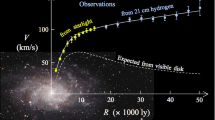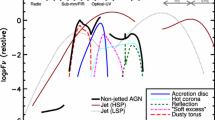Abstract
An analysis of the properties of 1157 galaxies, groups and clusters of galaxies confirms the dependence of the virial velocity on the halo mass \({{v}_{{{\text{vir}}}}} = {{v}_{m}}{{({{M}_{{{\text{vir}}}}}{\text{/}}{{10}^{{12}}}{\kern 1pt} {{M}_{ \odot }})}^{{1/3}}}\) with a single exponent and different values of \({{v}_{m}} \simeq 400\) km/s for galaxies with \({{M}_{{{\text{vir}}}}} \leqslant {{10}^{{12}}}{\kern 1pt} {{M}_{ \odot }}\) and \({{v}_{m}} \simeq 160\) km/s for galaxy clusters with \({{M}_{{{\text{vir}}}}} \geqslant {{10}^{{12}}}{\kern 1pt} {{M}_{ \odot }}\). A single exponent confirms the high degree of universality of the dark matter halo formation processes, and the difference in values of \({{v}_{m}}\) corresponds to the well-known difference in the average densities of galaxies and galaxy clusters and introduces a new scale \(M \simeq {{10}^{{12}}}{\kern 1pt} {{M}_{ \odot }}\) into the perturbation power spectrum. Modern numerical models using the power spectrum obtained from the WMAP and Planck observations reproduce well the observed properties of galaxy clusters, but cannot reproduce the observed parameters of galaxies. It is also shown that the cusp in the dark matter density profile leads to a finite density of gas and stars at the center of the halos (Burkert profile).




Similar content being viewed by others
REFERENCES
E. Komatsu, K. M. Smith, J. Dunkley, C. L. Bennett, et al., Astrophys. J. Suppl. 192, 18 (2011).
P. A. R. Ade, N. Aghanim, M. Arnaud, M. Ashdown, et al., Astron. Astrophys. 594, A13 (2016).
N. Aghanim, Y. Akrami, M. Ashdown, J. Aumont, et al., Astron. Astrophys. 641, A6 (2020).
M. McQuinn, Ann. Rev. Astron. Astrophys. 54, 313 (2016).
J. S. Bullock and M. Boylan-Kolchin, Ann. Rev. Astron. Astrophys. 55, 343 (2017).
A. V. Zasov, A. S. Saburova, A. V. Khoperskov, and S. A. Khoperskov, Phys. Usp. 60, 3 (2017).
T. Naab and J. P. Ostriker, Ann. Rev. Astron. Astrophys. 55, 59 (2017).
J. Tumlinson, M. Peebles, and J. Werk, Ann. Rev. Astron. Astrophys. 55, 389 (2017).
R. Wechsler and J. Tinker, Ann. Rev. Astron. Astrophys. 56, 435 (2018).
P. Salucci, Astron. Astrophys. Rev. 27, 2 (2019).
J. Zavala and C. S. Frenk, Galaxies 7 (4), 81 (2019).
J. D. Simon, Ann. Rev. Astron. Astrophys. 57, 375 (2019).
I. de Martino, S. S. Chakrebarty, V. Cesare, A. Gallo, L. Ostorero, and A. Diaferio, Universe 6, 107 (2020).
L. Lovisari, S. Ettori, M. Gaspari, and P. Giles, Universe 7, 139 (2021).
T. Ishiyama, Astrophys. J. 788, 27 (2014).
J. Wang, S. Bose, C. Frenk, L. Gao, A. Jenkins, V. Springel, and S. D. M. White, Nature (London, U.K.) 585, 39 (2020).
A. Bayer, A. Banerjee, and Yu. Feng, J. Cosmol. Astropart. Phys. 2021(01), 016 (2021).
E. Di Valentino, L. A. Anchordoqui, O. Akarsu, Y. Ali-Haimoud, et al., Astropart. Phys. 131, 102604 (2021); arXiv: 2008.11283 [astro-ph.CO]; arXiv: 2008.11284 [astro-ph.CO]; arXiv: 2008.11285 [astro-ph.CO].
L. A. Anchordoqui, E. di Valentino, S. Pan, and W. Yang, J. High Energy Astrophys. 32, 28 (2021).
W. Beenakker and D. Venhoek, arXiv: 2101.01372 [astro-ph.CO] (2021).
S. Chandrasekhar, Rev. Mod. Phys. 15, 1 (1943).
D. Lynden-Bell, Mon. Not. R. Astron. Soc. 136, L101 (1967).
J. Fillmore and P. Goldreich, Astrophys. J. 281, 1 (1984).
A. Gurevich and K. Zybin, Phys. Usp. 38, 687 (1995).
M. Boylan-Kolchin, V. Springel, S. White, A. Jenkins, and G. Lemson, Mon. Not. R. Astron. Soc. 398, 1150 (2009).
A. Klypin, S. Trujillo-Gomez, and J. Primack, Astrophys. J. 740, 102 (2011).
A. Klypin, G. Yepes, S. Gottlöber, F. Prada, and S. Heß, Mon. Not. R. Astron. Soc. 457, 4340 (2016).
T. J. Armitage, D. J. Barnes, S. T. Kay, Y. M. Bahe, C. dalla Vecchia, R. A. Crain, and T. Theuns, Mon. Not. R. Astron. Soc. 474, 3746 (2018).
L. Lovisari, G. Schellenberger, M. Sereno, S. Ettori, et al., Astrophys. J. 892, 102 (2020).
C. Sifón, H. Hoekstra, M. Cacciato, M. Viola, F. Kohlinger, R. F. J. van der Burg, D. J. Sand, and M. L. Graham, Astron. Astrophys. 575, A48 (2015).
M. Arnaud, E. Pointecouteau, and G. W. Pratt, Astron. Astrophys. 441, 893 (2005).
E. Pointecouteau, M. Arnaud, and G. W. Pratt, Astron. Astrophys. 435, 1 (2005).
G. W. Pratt, M. Arnaud, and E. Pointecouteau, Astron. Astrophys. 446, 429 (2006).
J. Merten, M. Meneghetti, M. Postmaan, K. Umetsu, et al., Astrophys. J. 806, 4 (2015); arXiv: 1404.1376 [astro-ph.CO].
R. Herbonnet, C. Sifón, H. Hoekstra, Y. Bahé, et al., arXiv: 1912.04414 [astro-ph.CO] (2019).
Z. Zhu, H. Xu, J. Wang, J. Gu, et al., arXiv: 1511.04699 [astro-ph.CO] (2019).
D. Makarov and I. Karachentsev, Mon. Not. R. -Astron. Soc. 412, 2498 (2011).
M. G. Walker, M. Mateo, E. W. Olszewski, J. Penarrubia, N. W. Evans, and G. Gilmore, Astrophys. J. 704, 1274 (2009).
J. S. Gannon, B. T. Dullo, D. A. Forbes, R. M. Rich, et al., Mon. Not. R. Astron. Soc. 502, 3144 (2021).
A. Sipolsand and A. Pavlovich, Galaxies 8, 36 (2020).
B. Epinat, P. Amram, M. Marcelin, C. Balkowski, et al., Mon. Not. R. Astron. Soc. 388, 500 (2008).
B. Epinat, P. Amram, and M. Marcelin, Mon. Not. R. Astron. Soc. 390, 466 (2008).
D. Bizyaev, D. I. Makarov, V. P. Reshetnikov, A. V. Mosenkov, S. J. Kautsch, and A. V. Antipova, Astrophys. J. 914, 104 (2021).
M. Demiański, A. Doroshkevich, N. Larchenkova, and S. Pilipenko, Astron. Rep. 64, 883 (2020).
M. Demiański and A. Doroshkevich, arXiv: 2009.04256 [astro-ph.CO] (2020).
J. Shull, B. Smith, and C. Danforth, Astrophys. J. 759, 23 (2012).
G. Voit, Adv. Space Res. 36, 701 (2005).
A. E. Evrard, J. Bialek, M. Busha, M. White, et al., Astrophys. J. 672, 122 (2008).
M. Demiański, A. Doroshkevich, and T. Larchenkova, Astron. Lett. 46, 359 (2020).
A. Klypin, I. Karachentsev, D. Makarov, and O. Nasonova, Mon. Not. R. Astron. Soc. 454, 1798 (2015).
J. Nawarro, C. Frenk, and S. White, Mon. Not. R. Astron. Soc. 275, 720 (1997).
J. Nawarro, C. Frenk, and S. White, Astrophys. J. 490, 493 (1997).
D. Marchesini, E. D’Onghia, G. Chincarini, C. Firmani, P. Conconi, E. Molinari, and A. Zacchei, Astrophys. J. 575, 801 (2002).
M. Demiański, A. Doroshkevich, and T. Larchenkova, Astron. Lett. (2022, in press).
A. Burkert, Astrophys. J. 447, L25 (1995).
D. R. Weisz, E. D. Skillman, S. L. Hidalgo, M. Monelli, et al., Astrophys. J. 789, 24 (2014).
D. R. Weisz, A. E. Dolphin, E. D. Skillman, J. Holtzman, K. M. Gilbert, J. J. Dalcanton, and B. F. Williams, Astrophys. J. 789, 147 (2014).
W. Press and P. Schechter, Astrophys. J. 187, 425 (1974).
J. Bond, S. Cole, G. Efstathiou, and N. Kaiser, Astrophys. J. 379, 440 (1991).
R. Sheth and G. Tormen, Mon. Not. R. Astron. Soc. 329, 61 (2002).
R. Sheth, Mon. Not. R. Astron. Soc. 345, 1200 (2003).
R. Sheth and G. Tormen, Mon. Not. R. Astron. Soc. 350, 1385 (2004).
R. Sheth and G. Tormen, Mon. Not. R. Astron. Soc. 349, 1464 (2004).
J. Silk, Astrophys. J. 151, 459 (1968).
Ya. Zel’dovich and I. Novikov, Relativistic Astrophysics, Vol. 2: The Structure and Evolution of the Universe (Nauka, Moscow, 1975; Univ. Chicago Press, Chicago, 1983).
J. Bardeen, J. Bond, N. Kaiser, and A. Szalay, Astrophys. J. 304, 15 (1986).
A. Doroshkevich, M. Khlopov, R. Sunyaev, A. Szalay, and Ya. Zeldovich, Ann. (N.Y.) Acad. Sci. 375, 32 (1981).
G. Blumenthal, H. Pagels, and J. Primack, Nature (London, U.K.) 299, 37 (1982).
M. Viel, J. Lesgourgues, M. Haehnelt, S. Matarrese, and A. Riotto, Phys. Rev. D 71, 063534 (2005).
A. Serebrov, R. Samoilov, and M. Chaikovskii, arXiv: 2109.12385 [hep-ph] (2021).
V. V. Barinov, R. A. Burenin, D. S. Gorbunov, and R. A. Krivonos, Phys. Rev. D 103, 063512 (2021).
V. V. Barinov, B. T. Cleveland, S. N. Danshin, H. Ejiri, et al., arXiv: 2109.11482 [nucl-ex] (2021).
V. Barinov and D. Gorbunov, arXiv: 2109.14654 [hep-ph] (2021).
N. Fiza, M. Masud, and M. Mitra, J. High Energy Phys. 2021 (09), 16 (2021).
S. Schoppmann, arXiv: 2109.13541 [hep-ex] (2021).
V. Khruschov and S. Fomichev, Universe 8, 97 (2022).
A. E. Bayer, F. Villaescusa-Navarro, E. Massara, J. Liu, et al., arXiv: 2102.05049 [astro-ph.CO] (2021).
G. Parimbelli, G. Scelfo, S. K. Giri, A. Schneider, M. Archidiacono, S. Camera, and M. Viel, arXiv: 2106.04588 [astro-ph.CO] (2021).
A. V. Kravtsov, Astrophys. J. Lett. 764, L31 (2013).
ACKNOWLEDGMENTS
The authors are grateful to the referee for constructive comments.
Funding
The work was partially carried out within the framework of the FIAN NNG 41-2020 project.
Author information
Authors and Affiliations
Corresponding author
Additional information
Translated by T. Sokolova
Appendices
APPENDIX I
1.1 DENSITY PROFILE OF THE DM HALO
Numerical models indicate that a typical DM halo density profile is well described by a simple formula [51]:
Two constants \({{\rho }_{0}},\;{{r}_{0}}\) (or \({{M}_{0}},\;{{v}_{0}}\)) determine the parameters of the DM halo. The often-discussed difference between the observed stellar density profile and (25) (the core–cusp problem) was discussed above in Section 4.
With such a density profile, the gravitational potential \(\Phi (x)\) is equal to
thus
where \({{R}_{{{\text{vir}}}}}\) is the virial radius.
The density profile (25) requires the introduction of an artificial virial radius. Numerous attempts to introduce a natural definition of the virial radius \({{R}_{{{\text{vir}}}}}\) have not been successful [79]. Based on observations of galaxy clusters [31, 34] \({{c}_{{{\text{vir}}}}} \simeq 4{-} 7\).
For the density profile (25), the circular velocity \({{v}_{c}}\) weakly depends on the radius
This means that in such a model, the observed dependence (1) \({{v}_{{{\text{vir}}}}}(M) \propto M_{{{\text{vir}}}}^{{1/3}}\) leads to the dependence of the basic parameters of the DM halo and \({{c}_{{{\text{vir}}}}}\):
These relations relate the basic parameters of the DM halo (\({{v}_{0}},\;{{M}_{0}},\;{{r}_{0}},\;{{\rho }_{0}}\)) to the virial parameters (\({{R}_{{{\text{vir}}}}},\;{{c}_{{{\text{vir}}}}},\;{{M}_{{{\text{vir}}}}}\)), and the DM halo population becomes a one-parameter population. The same relations simplify the use of the observed rotation curves of galaxies to determine the function \({{v}_{{{\text{vir}}}}}({{M}_{{{\text{vir}}}}})\).
APPENDIX II
1.1 ROTATION CURVES OF THE DM HALO
For the density profile (25) far from the center \((x \geqslant 2)\), the gravitational potential changes slowly, which makes it possible to do without knowing the exact value of the virial radius. Feature (27) of the d-ensity profile of the DM halo (partially) explains the observations of a flat velocity profile at the periphery of the DM halo. The same feature makes it possible to estimate the virial mass and circular velocity of the DM halo (3) without specifying the actual value of \({{R}_{{{\text{vir}}}}}\).
The catalogs of galaxy rotation curves contain the observed radial velocity dispersions of stars, which in a centrally symmetric gravitational field are related to the gravitational potential and proper random motions of stars
where \(\xi \) is the distance from the halo center in the plane of the sky, \(v_{0}^{2}\langle \phi (\xi )\rangle \) is the DM potential averaged over the line of sight, and \({{v}_{T}}(\xi )\) is the speed of the random motion of stars.
For the considered model (25)
and this feature of potential (26) explains the observed weak dependence \(\sigma _{v}^{2}(\xi )\).
For 31 dwarf galaxies studied in [38], estimates of the mass and dispersion of radial velocities at a radius of half the luminosity \({{r}_{{1/2}}}\) make it possible to compare the values \(\langle \sigma _{v}^{2}({{r}_{{1/2}}})\rangle \) and velocities \(v_{{1/2}}^{2} = GM({{r}_{{1/2}}}){\text{/}}{{r}_{{1/2}}}\) at this radius. For average values, we get
and for such radii, the influence of random motions of stars is comparable to the gravitational potential of DM. But near the outer boundary, the radial velo-cities and the averaging length are small, and \(v_{T}^{2}(\xi ) \ll \sigma _{v}^{2}(\xi ) \simeq v_{{{\text{vir}}}}^{2}\).
Rights and permissions
About this article
Cite this article
Demyansky, M., Doroshkevich, A., Larchenkova, T. et al. Galaxies and Clusters of Galaxies in Observations and Numerical Models. Astron. Rep. 66, 766–777 (2022). https://doi.org/10.1134/S1063772922100043
Received:
Revised:
Accepted:
Published:
Issue Date:
DOI: https://doi.org/10.1134/S1063772922100043




